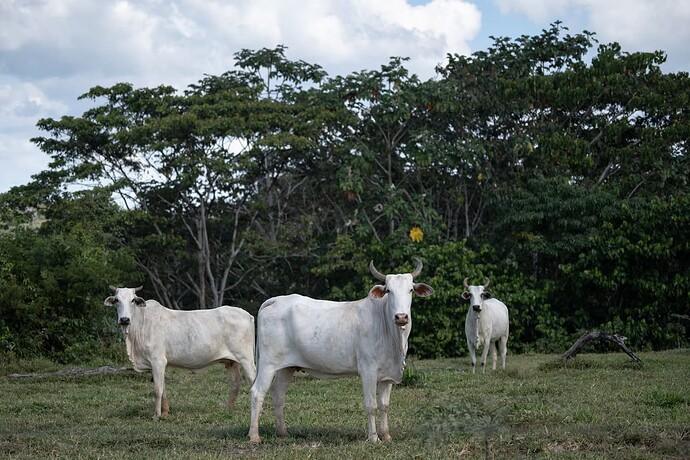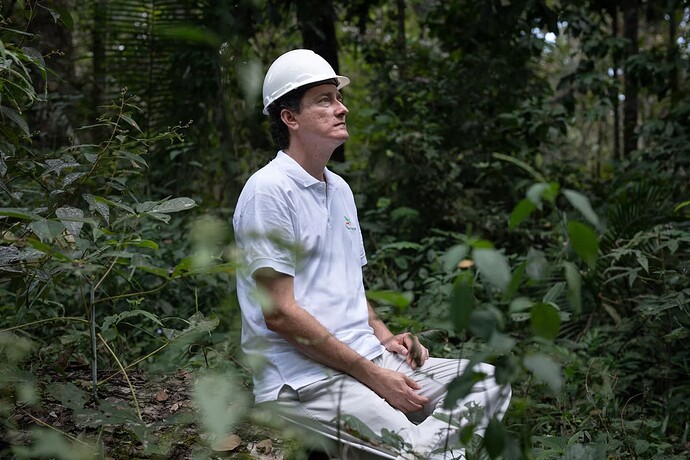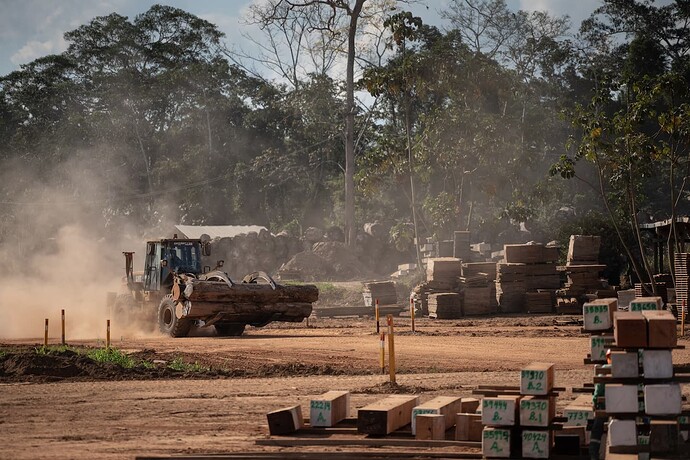IÑAPARI, Peru — At the entrance to its sprawling tract of virgin Amazon rainforest, the Peruvian timber company Maderacre turns ancient hardwood trees into flooring on an industrial scale.
Beside the vast, modern facility, a reddish dirt road leads into the jungle where workers harvest wood that takes centuries to mature.
As it systematically removes the oldest trees from this stunning wilderness, Maderacre might seem an improbable seller of carbon credits, the financial instrument that in theory allows consumers and corporations to “offset” their greenhouse gas emissions from air travel, ride-hailing apps, fashion purchases and other pollution-producing activities.
The company isn’t earning credits by planting trees to absorb carbon dioxide. The offsets it sells are based on a hypothetical: An estimate of how many existing trees it prevents from being cut down.
There’s a logic to this. Maderacre argues that unlike its neighbors — illegal loggers and homesteaders — it’s carrying out selective, sustainable logging on its 1,000-square-mile timber concession that maintains the forest’s ecological balance.
But the approach, known as Reducing Emissions from Deforestation and Degradation, or REDD+, raises questions about how to protect the world’s forests, which sequester billions of tons of carbon, and about the booming carbon credit market. As the window to avoid catastrophic climate change closes, scientists are questioning the intricate methodologies used to calculate this lucrative counterfactual, known as “avoided deforestation.”
Some warn that it might actually be accelerating the climate crisis, as consumers, instead of curbing their emissions, buy credits that do not deliver on their green promises.
A group of cows graze in a deforested part of a primary forest in Madre de Dios, Peru. Livestock farming further contributes to the deforestation of forests when animals step on or eat grass, deteriorating the soil.
The stark contrast between Maderacre’s lush concession and the barren land around it makes the benefits of offsets seem obvious. Pressing up against the forest’s perimeter is a patchwork of dusty fields cleared by unregulated deforesters in a chaotic rush to settle this remote region.
Household brands such as Shell, Southwest Airlines, Disney and Gucci all have used credits generated this way.
Southwest stressed that it offered credits to passengers on an optional basis but was not using them as part of its net zero strategy. Shell declined to comment. Disney and Gucci did not respond to requests to comment.
According to S&P Global Commodity Insights, REDD+ represents nearly a third of the voluntary carbon market, worth $2 billion in 2021 but predicted to hit as much as $40 billion a year by 2030.
But Britaldo Soares, the professor at Brazil’s Minas Gerais Federal University who created the software used by Maderacre, calls REDD+ a “climate scam.”
“This is a logging concession,” he said. He developed his Dinamica EGO program to measure the impact of government policies, he said, not to calculate credits. That’s the equivalent, he said, of “predicting the future with a crystal ball.”
Maderacre employees work in the production of wood in Madre de Dios, Peru.
A Maderacre worker piles wood products in Madre de Dios, Peru.
Barbara Haya, who heads the Carbon Trading Project at the University of California at Berkeley, said REDD+ projects around the world are generating “phantom” credits.
The reason, she said, is simple: “Everyone at the table benefits from more credits. There’s over-crediting every which way you turn. It’s systematic.”
By “everyone,” she means project developers, the certification companies that set the rules, and the third-party auditors who determine whether a project is preventing forest loss.
The latter two, she stressed, have an incentive to approve projects, because rejecting them could deter others from contracting their services.
With some projects generating millions of credits, each representing a metric ton of carbon and trading for about $1.40 — sometimes significantly more — the temptation to exaggerate avoided emissions is powerful.
Verra, the nonprofit that holds a 70 percent share of the global carbon project verification market, has to date issued 1.23 billion credits. But it isn’t paid only for certification. The group also gets 20 cents per credit sold. Haya calls that a conflict of interest.
Doubts exist around the baselines, the predictions of deforestation that would occur without a carbon concession. These are calculated in various ways, including projections from historical forest loss and comparisons with other parts of the forest.
“Maybe they’re deliberately exaggerated,” said Erin Sills, an environmental economist at North Carolina State University. “But it’s also perhaps because project developers are trying to predict the future. That’s never possible.”
Then there’s “additionality,” the concept that for emissions to have been avoided, the revenue generated by carbon credits must make the difference between the forest being saved or destroyed.
Additionality is difficult to calculate because most carbon projects are layered onto preexisting uses of the land: sustainable logging such as Maderacre’s, ecotourism, Brazil-nut gathering — even protected areas with bans on extractive activities. Many should already have safeguards, such as security guards or perimeter fencing.
Sills is one of eight researchers who examined dozens of forest carbon concessions in Africa, Asia and Latin America. In a paper published last year in Science, they found most reduced far less deforestation than was claimed.
Of the 89 million carbon credits that the projects generated, they concluded, only 5.4 million represented genuine reductions in emissions.
Maderacre had generated nearly 9.7 million credits by late 2021 for buyers including Canada’s Scotiabank and the gas-guzzling Dakar Rally. The researchers said they found no evidence that the effort had achieved the deforestation claimed. (Scotiabank declined to comment; the Dakar Rally did not respond to a request for comment.)
That analysis is backed by Soares. “Since it’s already a [timber] concession and they have the obligation of conserving it,” he said, “there’s no additionality at all.”
Nelson Kroll, a manager at Maderacre, disagrees. “Timber is timber, not oil or gold,” he said. “A business based just on logging can’t pay for everything you need to conserve the forest.”
A Maderacre worker moves logs.
Verra acknowledges that calculating avoided emissions is complex and imperfect but disputes the researchers’ conclusions. The organization stresses that the “voluntary” carbon market was created by the private sector, pushed by consumer demand, to plug a gap left by governments’ failure to set compulsory offset standards in the U.N. climate negotiations.
“The best hasn’t happened, but the good’s done a lot of good,” Verra spokesman Joel Finkelstein said. The group constantly updates its methodologies, sometimes in response to harsh criticism from academics and environmentalists.
“The science 15 years ago was very different to the science now,” Finkelstein said. “At every point, we’ve been aiming for the best standard.”
On Maderacre’s concession, squawking red and blue macaws swoop overhead as capuchin monkeys frolic in the canopy. The jaguar population is so dense that the San Diego Zoo Wildlife Alliance runs a research project on the alpha predator.
View of the religious community of Arca Pacahuara, where many residents work in agriculture in the forests of Madre de Dios, Peru.
But on the neighboring plots, Cebu cattle dot brown fields of low-quality pasture. Small, in many cases failed and abandoned, plantations of teak — not native to the Amazon — break up the terrain. Columns of smoke tower on the horizon.
The ecocide has been driven by the Interoceanic Highway. The 1,600-mile road, completed in 2011, was intended to connect Brazilian commodities to Peru’s Pacific ports to feed China’s insatiable economy.
Little freight now passes along the highway. Former Peruvian President Alejandro Toledo, who launched the highway with Brazilian President Luis Inácio Lula da Silva, is now in pretrial detention, accused of taking a $25-million bribe in return for contracts to build it.
Yet the road has, literally, paved the way to destruction for this corner of the Amazon. Maderacre has at least kept the deforestation from overwhelming its concession.
“The deforestation’s real, and someone has to do the work,” said Kroll, a forestry engineer who previously worked as an Amazon park guard.
He stresses that Maderacre harvests one tree per hectare every 30 years, and takes only shihuahuaco trunks with diameters more than 75 centimeters (almost 30 inches), a stricter standard than the legal minimum of 51 centimeters.
“This isn’t a timber concession. It’s a nature concession,” Kroll said. “Until we find ways for living forests to be economically competitive, they’re going to continue being decimated.”
Sills believes sweeping change is needed.
“We rely on these offsets to reduce our own footprints, but the result is net higher emissions,” she said. “The climate’s the real loser.”
Reporting for this story was supported by a travel grant from the Pulitzer Center on Crisis Reporting.





